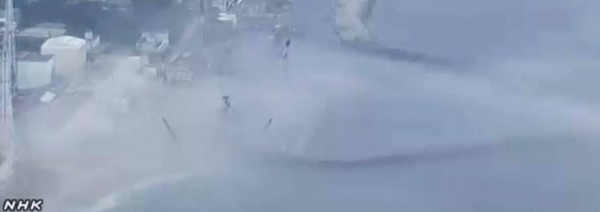
The news lately has been featuring troubles at Fukushima Daiichi, a situation that has been getting steadily worse for the past couple of months, as Japan has repeatedly called for help from the world nuclear industry and their governments, which strangely (or not so strangely) doesn't appear to be forthcoming. In a rather alarming item, a VOR [Voice of Russia] report entitled Fukushima radioactive leak causes the sea off Japan coast to boil was picked up by BBC and linked on their website, and it has gone viral with a photo on Twitter from VOR. From the report:
The sea is boiling off of the coast of Fukushima, Japan, and the picture of this devastating phenomenon has recently been called the photo of the day by Coolbuster. While it certainly can't be good for any plant or animal life left off the coast of Japan, it might have even worse consequences for the North American continent. If Fukushima radiation keeps leaking, the boiling seas are likely to spread all the way across the Pacific Ocean to the West Coast of the US causing a massive environmental catastrophe.
No, the sea isn't boiling. Yet...
Well, hopefully I can help a little bit here to calm some nerves about the most frightening of news coming out of Fukushima. Just so you know, the VOR report is hyperbolic nonsense - the sea isn't boiling, and even if it were it couldn't boil all the way to North America. So take it down a few notches, then we can look at reality.
What is actually happening is that the corium lavas that are what's left of the three reactor cores than experienced "China Syndrome" meltdowns two and a half years ago, have reached the water table beneath the plants. The good news on that is that none of them managed to cause the original "Worst Case Scenario" that has a super-heated pressurized steam reaction beneath a layer of caprock causing a major 'hydrovolcanic' explosion where the whole facility goes sky high.
The bad news is that over these past weeks the groundwater level has been steadily rising, and it finally hit the surface this weekend. This has caused deadly levels of radiation from standing water at various places around the facility, in the range of 1.8 to as much as 10 Sieverts per hour on contact. An estimated 1,000 tons of groundwater rushes into the complex every day, picks up contamination, and flows on out into the Pacific. TEPCO hopes to install pumps uphill of the facility to divert some of the flow. Someday. Maybe.
There is also the issue of leaking storage tanks for the highly radioactive coolant being pumped into and out of the basements every day. Which is then pumped to the tanks. They were filtering it to reduce cesium at one point early on, but the cheap piping (basically dryer hose stuff) froze the first winter, I can't find that they're still using the system. The tanks are themselves pretty shitty and were never meant to last very long.
TEPCO coated the bottom of the lagoon inside the seawalls with a fairly thick layer of borated/clay concrete awhile back. That is no longer stopping the groundwater flow, and the water that has been in contact with corium is very warm, so steam is rising. It is not actually boiling in the lagoon, and won't unless the corium is actually sitting in the lagoon. Steam is being produced, which is coming out here and there, like the steam and boiling water spouts that began erupting on the facility grounds back in June of 2011. Only moreso.
The corium lavas were never really going to go all the way through the earth. Like any liquid, even a not-very viscous liquid, it would follow the 'path of least resistance', which means following the natural flow of the groundwater to the sea. The corium flows can thus be approximated now as being within mere meters of the cliff face and/or ocean bottom of the lagoon. Heating the water it's in contact with and releasing lots of nasty elements in the process.
It's a mud-pit. Biggest danger is destabilization of the ruins that are still holding overstuffed spent fuel pools four stories in the air. And that is the reason the world nuclear industry and their governments need to get off their duffs and do what can be done about the situation.
Now the Japanese government and TEPCO are planning to freeze the ground two miles long and to perhaps 100 feet in depth, to wall off the facilities from the aquifer's flow and stabilize the ground enough to hold up the ruins. And they expect to be done with it by 2015. Finish date, specs and costs may of course be adjusted along the road, as things nuclear always are.
Many engineers are skeptical of the plan, for a number of reasons. There is the radiation hazard to workers, of course. And the fact that frozen walls have in the past been in use for just a couple of years (costs making them impractical for longer than that), while the most optimistic projection for decommissioning of Daiichi is sixty years. If the world nuclear industry and their host governments could be enlisted to help deal with the situation (and pay for it) we might be able to expect some innovative new technologies to be developed and deployed at Daiichi over the course, but there aren't any indications lately that either the nukes or their governments care to deal with what is most certainly NOT Japan's little problem.
They will, of course, keep right on insisting that we need a couple thousand new nukes in the next 50 years or so. All the while pretending Daiichi isn't their problem or anyone's concern. I hope the situation remains forevermore that Nobody's Buying.


